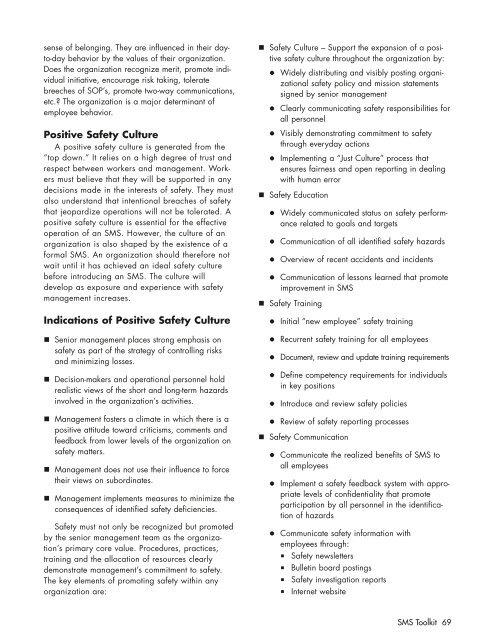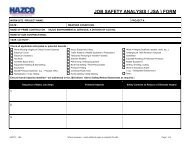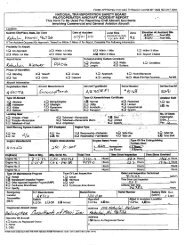International Helicopter Safety Team Safety Management System Toolkit
IHST - Safety Management Toolkit - Skybrary
IHST - Safety Management Toolkit - Skybrary
- No tags were found...
Create successful ePaper yourself
Turn your PDF publications into a flip-book with our unique Google optimized e-Paper software.
sense of belonging. They are influenced in their dayto-day<br />
behavior by the values of their organization.<br />
Does the organization recognize merit, promote individual<br />
initiative, encourage risk taking, tolerate<br />
breeches of SOP’s, promote two-way communications,<br />
etc.? The organization is a major determinant of<br />
employee behavior.<br />
Positive <strong>Safety</strong> Culture<br />
A positive safety culture is generated from the<br />
“top down.” It relies on a high degree of trust and<br />
respect between workers and management. Workers<br />
must believe that they will be supported in any<br />
decisions made in the interests of safety. They must<br />
also understand that intentional breaches of safety<br />
that jeopardize operations will not be tolerated. A<br />
positive safety culture is essential for the effective<br />
operation of an SMS. However, the culture of an<br />
organization is also shaped by the existence of a<br />
formal SMS. An organization should therefore not<br />
wait until it has achieved an ideal safety culture<br />
before introducing an SMS. The culture will<br />
develop as exposure and experience with safety<br />
management increases.<br />
Indications of Positive <strong>Safety</strong> Culture<br />
Senior management places strong emphasis on<br />
safety as part of the strategy of controlling risks<br />
and minimizing losses.<br />
Decision-makers and operational personnel hold<br />
realistic views of the short and long-term hazards<br />
involved in the organization’s activities.<br />
<strong>Management</strong> fosters a climate in which there is a<br />
positive attitude toward criticisms, comments and<br />
feedback from lower levels of the organization on<br />
safety matters.<br />
<strong>Management</strong> does not use their influence to force<br />
their views on subordinates.<br />
<strong>Management</strong> implements measures to minimize the<br />
consequences of identified safety deficiencies.<br />
<strong>Safety</strong> must not only be recognized but promoted<br />
by the senior management team as the organization’s<br />
primary core value. Procedures, practices,<br />
training and the allocation of resources clearly<br />
demonstrate management’s commitment to safety.<br />
The key elements of promoting safety within any<br />
organization are:<br />
<strong>Safety</strong> Culture – Support the expansion of a positive<br />
safety culture throughout the organization by:<br />
<br />
<br />
<br />
<br />
Widely distributing and visibly posting organizational<br />
safety policy and mission statements<br />
signed by senior management<br />
Clearly communicating safety responsibilities for<br />
all personnel<br />
Visibly demonstrating commitment to safety<br />
through everyday actions<br />
Implementing a “Just Culture” process that<br />
ensures fairness and open reporting in dealing<br />
with human error<br />
<strong>Safety</strong> Education<br />
<br />
<br />
<br />
<br />
Widely communicated status on safety performance<br />
related to goals and targets<br />
Communication of all identified safety hazards<br />
Overview of recent accidents and incidents<br />
Communication of lessons learned that promote<br />
improvement in SMS<br />
<strong>Safety</strong> Training<br />
<br />
<br />
<br />
<br />
<br />
<br />
Initial “new employee” safety training<br />
Recurrent safety training for all employees<br />
Document, review and update training requirements<br />
Define competency requirements for individuals<br />
in key positions<br />
Introduce and review safety policies<br />
Review of safety reporting processes<br />
<strong>Safety</strong> Communication<br />
<br />
<br />
<br />
Communicate the realized benefits of SMS to<br />
all employees<br />
Implement a safety feedback system with appropriate<br />
levels of confidentiality that promote<br />
participation by all personnel in the identification<br />
of hazards<br />
Communicate safety information with<br />
employees through:<br />
<strong>Safety</strong> newsletters<br />
Bulletin board postings<br />
<strong>Safety</strong> investigation reports<br />
Internet website<br />
SMS <strong>Toolkit</strong> 69







